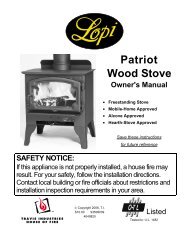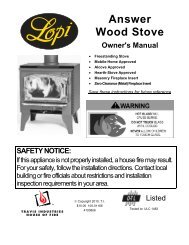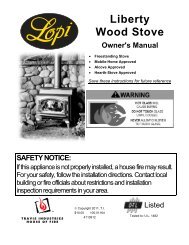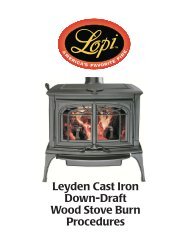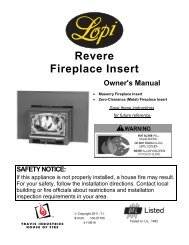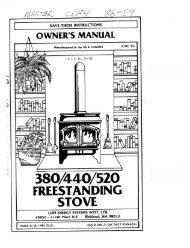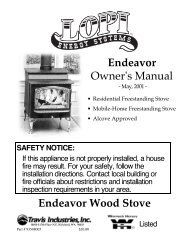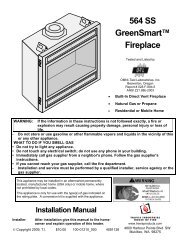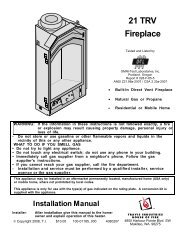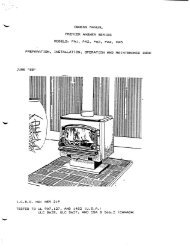S h e f f i e l d Wood Stove - Lopi
S h e f f i e l d Wood Stove - Lopi
S h e f f i e l d Wood Stove - Lopi
You also want an ePaper? Increase the reach of your titles
YUMPU automatically turns print PDFs into web optimized ePapers that Google loves.
24 Maintaining Your Appliance<br />
Monthly Maintenance (while appliance is in use)<br />
Make sure the appliance has fully cooled prior to conducting service.<br />
Door and Glass Inspection<br />
The door must form an air-tight seal to the firebox for the stove to work correctly. Inspect the door<br />
gasket to make sure it forms an air-tight seal to the firebox.<br />
The door can be un-bolted from the the hinges if extensive repairs are conducted.<br />
If the glass is damaged, replace<br />
it - see “Replacement Parts” for<br />
details.<br />
<br />
<br />
<br />
<br />
<br />
<br />
<br />
<br />
<br />
<br />
<br />
<br />
<br />
<br />
<br />
High-Temperature<br />
anti-sieze may be<br />
used on the door<br />
hinges to eliminate<br />
squeaks. <br />
Use wood stove gasket<br />
cement to re-adhere<br />
loose gasket.<br />
<br />
<br />
<br />
<br />
<br />
<br />
<br />
<br />
<br />
<br />
<br />
<br />
<br />
<br />
<br />
Severely frayed or thread-bare<br />
gasket should be replaced.<br />
The door latch should pull the door against the face of the stove (but not so tight as to not allow full<br />
handle rotation). If the latch requires adjustment, follow the directions below.<br />
7/16" Wrench<br />
The hinge support can<br />
be adjusted to better<br />
align the door.<br />
7/16" Wrench<br />
The door latch catch<br />
can be adjusted to<br />
better align the door.<br />
Creosote - Formation and Need for Removal<br />
<br />
<br />
<br />
<br />
<br />
<br />
<br />
<br />
<br />
<br />
<br />
<br />
<br />
<br />
<br />
When wood is burned slowly, it produces tar and other organic vapors, which combine with expelled<br />
moisture to form creosote. The creosote vapors condense in the relatively cool chimney flue of a slowburning<br />
fire. As a result, creosote residue accumulates on the flue lining. When ignited, this creosote<br />
makes an extremely hot fire. The chimney and chimney connector should be inspected at least once<br />
every two months during the heating season to determine if a creosote buildup has occurred. If<br />
creosote has accumulated, it should be removed to reduce the risk of a chimney fire.<br />
If you are not certain of creosote inspection, contact your dealer or local chimney sweep for a full<br />
inspection. Excess creosote buildup may cause a chimney fire, that may result in property damage,<br />
injury, or death.<br />
Travis Industries 93508129 4020204



